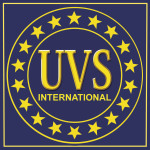In the run up to UVS International’s RPAS 2013 Conference being held at the Royal Military Academy in Brussels on the 24th to the 27th of June, we’ll be taking a detailed look at some of the presentations planned covering the key topics.
The Conference is scheduled to start at lunch time on Monday, allowing delegates to travel during the morning. So the opening sessions take place that afternoon, with one of the key topics being the European Road Map. Session 2 kicks off with a look at the current status of RPAS regulations in France, Sweden and the UK.
First up, Arnaud Grut of the DGAC, France will present “The First Year of French RPAS Implementation”
 In April 2012, the DGAC France published a new regulation addressing civil aviation RPAS below 150 kg used for aerial work. RPAS below 25 kg can now be authorised for aerial work on a routine basis when such operations are conducted according to 4 predefined operational scenarios addressing VLOS / BVLOS condition and flight over populated / non populated areas.
In April 2012, the DGAC France published a new regulation addressing civil aviation RPAS below 150 kg used for aerial work. RPAS below 25 kg can now be authorised for aerial work on a routine basis when such operations are conducted according to 4 predefined operational scenarios addressing VLOS / BVLOS condition and flight over populated / non populated areas.
All other operations not falling within the limit of these scenarios – and/or with RPAS above 25 kg – are dealt with on a case-by-case basis. Aerial work operations can occur in non-segregated airspace but below a 150 m limit altitude (reduced to 50 m in some cases) and out of any aerodrome circulation, controlled airspace and restricted area. No operation can occur closer than a 30 m horizontal distance from people not related to the activity. RPAS do not undergo a certification process but have to be equipped with a minimum set of equipment/functions depending on the performed scenario.
No pilot licence is required but a minimum theoretical knowledge based on current existing licences for manned aviation. The operator is responsible for operation safety. He shall describe in a dedicated operation manual sent to the authority all the procedures he applies to comply with the regulation.
In a one year period, more than 200 operators have thus obtained a DGAC operational authorisation, representing more than 300 RPAS, mainly for aerial photography, video and survey activities.
Some RPAS manufacturers and operators have already expressed their wish to go beyond the predefined scenarios and are expecting a revision of the regulation allowing more ambitious operations. But this implies that DGAC will have to define appropriate technical conditions for such operations, based on the results of the current international efforts aimed at defining globally accepted standards for civil aviation RPAS.
Arnaud has a Masters in aeronautical engineering, ENAC engineer school in Toulouse and has been DGAC – PCM for general aviation certification projects (EASA and DGAC) since 2007.
Next, Christer Wikström of Transportstyrelsen, Sweden wiil give a presentation on “Experience & Lessons Learned in Swedish RPAS Regulation”
 The Swedish Transport Agency’s regulations on remotely piloted aircraft systems (RPAS) were published in 2009. They are also available in an (unofficial) version in English. At present there are 153 valid approvals in different categories within Sweden.
The Swedish Transport Agency’s regulations on remotely piloted aircraft systems (RPAS) were published in 2009. They are also available in an (unofficial) version in English. At present there are 153 valid approvals in different categories within Sweden.
The approvals apply to different purposes such as system development, photo missions, training etc. There are three different categories of approvals that can be sought. The categories are 1 (subdivided into A and B depending on weight and kinetic energy), 2 and 3, where 1 and 2 applies to operation within VLOS, and are divided into different weight classes. The weight of the different aircraft spans from less than a kilo up to just below 150 kg.
In category 3 there has not yet been any approvals issued. One of the obvious reasons for that is that the detect and avoid issue hasn’t been solved from a legal standpoint.
Christer has a background as a Maintenance Engineer and instructor in different aviation techniques, and also as a pilot in general aviation. He joined the Swedish CAA in 1995 and is currently one of two focal points for RPAS within the Swedish CAA. He is one of the members in the ICAO UASSG, and has also previously been involved in EUROCAE WG 73.
Then, Corbett, Gerry of the CAA, UK will discuss “Experience & Lessons Learned in UK RPAS Regulation”
 The presentation concentrates on the UK operation of ‘Small UAS’ as they are termed within UK Law – while the essential principles for the non-military operations of larger UAS/RPAS are in place, there has been little (if any) demand for such activities to date – this is thought to stem from the evident difficulties being discovered by the industry in satisfactorily addressing the airworthiness and BVLOS (Detect and Avoid) aspects.
The presentation concentrates on the UK operation of ‘Small UAS’ as they are termed within UK Law – while the essential principles for the non-military operations of larger UAS/RPAS are in place, there has been little (if any) demand for such activities to date – this is thought to stem from the evident difficulties being discovered by the industry in satisfactorily addressing the airworthiness and BVLOS (Detect and Avoid) aspects.
Within the UK, the operation of Small UAS (SUAS – Mass 20kg or less) has been the most prolific area of UAS development. SUAS operations are subject to specific regulations which are proportionate, but are primarily aimed at protecting third parties.
These basic regulations are essentially aimed at VLOS operations and, in most cases, apply equally to the flight of model aircraft and to small unmanned aircraft used for non-recreational purposes. The main differentiation is that a specific permission is required from the UK CAA if the aircraft is to be used for aerial work purposes, or for surveillance flights close to people or property as follows:
- Flight over, or within 150m of congested areas or open-air assemblies (more than 1000 persons)
- Flight within 50m of persons, vessels, vehicles or structures which are not under the control of the SUAS pilot.
There are currently over 180 sUAS operators flying with aerial work permissions in the UK; the majority of these operations involve aerial photography/filming and the surveying of buildings and land.
The UK CAA’s document CAP722 ‘Unmanned Aircraft System Operations in UK Airspace – Guidance’ contains the guidance that is required to enable current or prospective RPAS operators to operate in the UK, while complying with UK law and the principles of equivalence.
Gerry joined the CAA’s Safety Regulation Group in June 2012, where he is the CAA’s focal point for all matters associated with the operation of Unmanned Aircraft Systems in UK airspace. He is also the sponsor for Civil Aviation Publication 722, the primary guidance document for Unmanned Aircraft System Operations in UK Airspace.
A military Air Traffic Control Officer with over 26 years experience, he has served as a controller at airfield and Area Radar units ashore in the UK, and at sea worldwide from the RN’s Aircraft Carriers.
For the full programme with abstracts and speakers bio data, click here.
An online registration form is available here.

